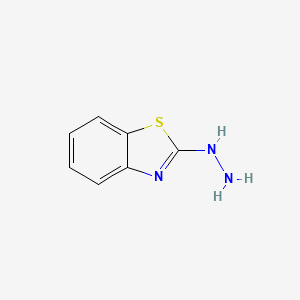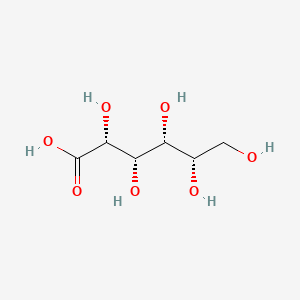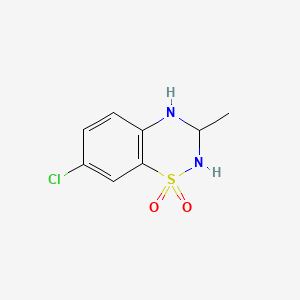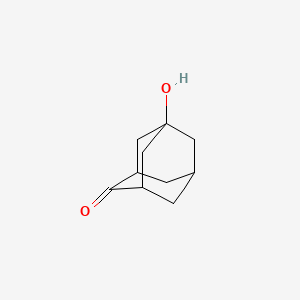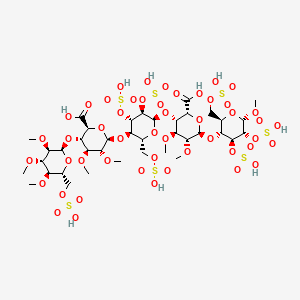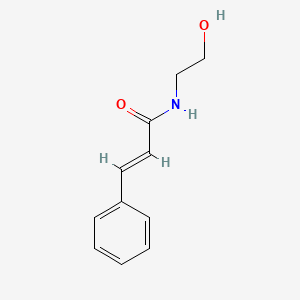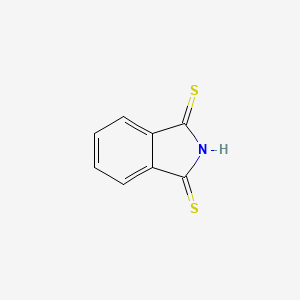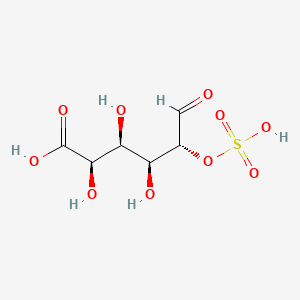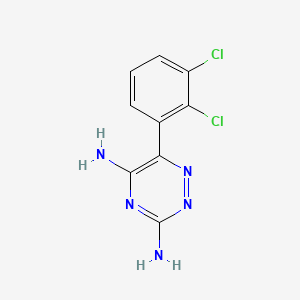
Lamotrigin
Übersicht
Beschreibung
Lamotrigine is a phenyltriazine compound widely used as an antiepileptic drug and mood stabilizer. It is primarily prescribed for the treatment of epilepsy, including focal seizures, tonic-clonic seizures, and seizures associated with Lennox-Gastaut syndrome. Additionally, lamotrigine is used to stabilize mood in individuals with bipolar disorder .
Wirkmechanismus
Target of Action
Lamotrigine, a phenyltriazine derivative, primarily targets voltage-sensitive sodium channels and possibly high-voltage-activated calcium channels in neurons . These channels play a crucial role in the regulation of neuronal excitability and the release of neurotransmitters .
Mode of Action
Lamotrigine acts by selectively binding to the inactive state of sodium channels , thereby inhibiting sodium currents . This action suppresses the release of excitatory amino acids such as glutamate and aspartate . It’s also suggested that lamotrigine might inhibit the release of excitatory neurotransmitters via voltage-gated calcium channels .
Biochemical Pathways
The primary biochemical pathway affected by lamotrigine is the neuronal signaling pathway . By inhibiting the influx of sodium ions through voltage-sensitive sodium channels, lamotrigine reduces the release of excitatory neurotransmitters . This action leads to a decrease in neuronal hyperexcitability and modification of synaptic plasticity .
Pharmacokinetics
Lamotrigine is well-absorbed along the entire length of the gastrointestinal tract . It is metabolized primarily by glucuronidation via UDP-glucuronyl transferases (UGT) in the liver . The main enzymes involved in its metabolism are UGT1A4 and UGT3B7 . Lamotrigine has a half-life of approximately 29 hours , and it is excreted in urine (65%) and feces (2%) .
Result of Action
The molecular and cellular effects of lamotrigine’s action include the inhibition of neuronal hyperexcitability and modification of synaptic plasticity . This results in a reduction of excessive neurotransmitter release in the brain . Clinically, these actions translate into the control of seizure activity in epilepsy and mood stabilization in bipolar disorder .
Action Environment
Environmental factors such as co-administration with other drugs can influence lamotrigine’s action, efficacy, and stability. For instance, when lamotrigine is used concurrently with carbamazepine, phenytoin, or phenobarbital, its plasma levels decrease by one-half . When it is used with valproic acid, the valproic acid levels are reduced by about 25%, and the lamotrigine levels double . These interactions are thought to be due to competition for hepatic glucuronide metabolism . Additionally, certain underlying cardiac disorders or arrhythmias may influence lamotrigine’s action .
Wissenschaftliche Forschungsanwendungen
Lamotrigin hat eine breite Palette von Anwendungen in der wissenschaftlichen Forschung:
Chemie: Wird als Modellverbindung in Studien zur Triazinchemie und Reaktivität verwendet.
Biologie: Untersucht auf seine Auswirkungen auf die neuronale Aktivität und die Freisetzung von Neurotransmittern.
Medizin: Wird umfassend auf seine therapeutischen Wirkungen bei Epilepsie und bipolarer Störung untersucht.
Industrie: Wird bei der Entwicklung neuer pharmazeutischer Formulierungen und Arzneimittelverabreichungssysteme eingesetzt .
5. Wirkmechanismus
This compound entfaltet seine Wirkungen, indem es neuronale Membranen stabilisiert und die Freisetzung von erregenden Neurotransmittern hemmt. Dies erreicht es durch Blockierung spannungsabhängiger Natriumkanäle und spannungsabhängiger Kalziumkanäle in Neuronen. Diese Wirkung reduziert die übermäßige Freisetzung von Glutamat und Aspartat, die wichtige erregende Neurotransmitter sind, die an Anfallsaktivität und Stimmungsregulation beteiligt sind .
Ähnliche Verbindungen:
Carbamazepin: Ein weiteres Antiepileptikum, das für ähnliche Indikationen verwendet wird, aber eine andere chemische Struktur aufweist.
Valproat: Wird bei Epilepsie und bipolarer Störung eingesetzt, hat aber einen breiteren Wirkmechanismus, der sich auf mehrere Neurotransmittersysteme auswirkt.
Topiramat: Ein Antiepileptikum mit zusätzlichen Anwendungen bei der Migräneprophylaxe, das sich in seinem Wirkmechanismus und seinem Nebenwirkungsprofil unterscheidet .
Einzigartigkeit von this compound: this compound ist aufgrund seiner Phenyltriazinstruktur einzigartig, die es von anderen Antikonvulsiva unterscheidet. Es hat ein relativ günstiges Nebenwirkungsprofil und erfordert keine regelmäßige Laborüberwachung, was es für viele Patienten zur bevorzugten Wahl macht .
Biochemische Analyse
Biochemical Properties
Lamotrigine plays a crucial role in biochemical reactions by interacting with various enzymes, proteins, and other biomolecules. It primarily inhibits voltage-sensitive sodium channels and voltage-gated calcium channels in neurons, reducing the release of excitatory neurotransmitters such as glutamate . This inhibition stabilizes neuronal membranes and prevents excessive neuronal firing, which is beneficial in controlling seizures and mood swings.
Cellular Effects
Lamotrigine affects various types of cells and cellular processes. It influences cell function by modulating cell signaling pathways, gene expression, and cellular metabolism. In neurons, Lamotrigine inhibits the release of excitatory neurotransmitters, thereby reducing neuronal excitability . This modulation of neurotransmitter release impacts cell signaling pathways and gene expression, leading to stabilized mood and reduced seizure activity.
Molecular Mechanism
The molecular mechanism of Lamotrigine involves its binding interactions with biomolecules, enzyme inhibition, and changes in gene expression. Lamotrigine binds selectively to inactivated voltage-sensitive sodium channels, inhibiting sodium currents and stabilizing neuronal membranes . It also inhibits voltage-gated calcium channels, further reducing the release of excitatory neurotransmitters . These actions contribute to its antiepileptic and mood-stabilizing effects.
Temporal Effects in Laboratory Settings
In laboratory settings, the effects of Lamotrigine change over time. The compound is rapidly absorbed and reaches steady-state plasma concentrations within five days . Lamotrigine exhibits autoinduction within the first two weeks of therapy, which may prolong the time to steady state . Long-term effects observed in in vitro and in vivo studies include changes in bone density and potential risks of osteoporosis and osteopenia .
Dosage Effects in Animal Models
The effects of Lamotrigine vary with different dosages in animal models. In mice and rats, the oral median lethal doses (LD50) are 245 mg/kg and 205 mg/kg, respectively . At lower doses, Lamotrigine induces lethargy and somnolence, while higher doses can cause life-threatening cardiac arrhythmias, seizures, and death . These findings highlight the importance of careful dosage management in clinical settings.
Metabolic Pathways
Lamotrigine is metabolized primarily through glucuronidation by UDP-glucuronosyltransferases in the liver . The principal pathway involves the formation of Lamotrigine N2-glucuronide, which is then excreted in the urine . This metabolic pathway is influenced by genetic polymorphisms, which can affect the clearance and response to Lamotrigine .
Transport and Distribution
Lamotrigine is well absorbed with a bioavailability approaching 100% . It is distributed within the body with a volume of distribution ranging from 0.9 to 1.3 L/kg . Lamotrigine is transported across the blood-brain barrier, likely involving organic cation transporters . It accumulates in the kidneys and is extensively metabolized in the liver .
Subcellular Localization
Lamotrigine’s subcellular localization involves its interaction with sodium channels in neuronal membranes . It binds to inactivated sodium channels, causing a tonic inhibition of sodium currents . This interaction primarily occurs in the neuronal membranes, contributing to its antiepileptic effects.
Vorbereitungsmethoden
Synthetic Routes and Reaction Conditions: Lamotrigine is synthesized through a multi-step process. The synthesis begins with the reaction of 2,3-dichlorobenzoyl chloride with hydrazine hydrate to form 2,3-dichlorobenzohydrazide. This intermediate is then cyclized with cyanogen bromide to produce 3,5-diamino-6-(2,3-dichlorophenyl)-1,2,4-triazine .
Industrial Production Methods: Industrial production of lamotrigine involves optimizing the reaction conditions to ensure high yield and purity. The process typically includes steps such as crystallization, filtration, and drying to obtain the final product in a form suitable for pharmaceutical use .
Analyse Chemischer Reaktionen
Reaktionstypen: Lamotrigin unterliegt verschiedenen chemischen Reaktionen, darunter:
Oxidation: this compound kann oxidiert werden, um seine N-Oxid-Derivate zu bilden.
Reduktion: Reduktionsreaktionen können this compound in seine entsprechenden Amin-Derivate umwandeln.
Substitution: this compound kann nucleophile Substitutionsreaktionen eingehen, insbesondere an den Chloratomen am Phenylring
Häufige Reagenzien und Bedingungen:
Oxidation: Häufige Oxidationsmittel sind Wasserstoffperoxid und Persäuren.
Reduktion: Reduktionsmittel wie Lithiumaluminiumhydrid und Natriumborhydrid werden verwendet.
Substitution: Nucleophile wie Amine und Thiole werden unter basischen Bedingungen eingesetzt
Hauptprodukte:
Oxidation: N-Oxid-Derivate.
Reduktion: Amin-Derivate.
Substitution: Substituierte Phenyltriazin-Derivate
Vergleich Mit ähnlichen Verbindungen
Carbamazepine: Another antiepileptic drug used for similar indications but with a different chemical structure.
Valproate: Used for epilepsy and bipolar disorder, but it has a broader mechanism of action affecting multiple neurotransmitter systems.
Topiramate: An antiepileptic with additional uses in migraine prevention, differing in its mechanism of action and side effect profile .
Uniqueness of Lamotrigine: Lamotrigine is unique due to its phenyltriazine structure, which distinguishes it from other anticonvulsants. It has a relatively favorable side effect profile and does not require regular laboratory monitoring, making it a preferred choice for many patients .
Eigenschaften
IUPAC Name |
6-(2,3-dichlorophenyl)-1,2,4-triazine-3,5-diamine | |
|---|---|---|
| Source | PubChem | |
| URL | https://pubchem.ncbi.nlm.nih.gov | |
| Description | Data deposited in or computed by PubChem | |
InChI |
InChI=1S/C9H7Cl2N5/c10-5-3-1-2-4(6(5)11)7-8(12)14-9(13)16-15-7/h1-3H,(H4,12,13,14,16) | |
| Source | PubChem | |
| URL | https://pubchem.ncbi.nlm.nih.gov | |
| Description | Data deposited in or computed by PubChem | |
InChI Key |
PYZRQGJRPPTADH-UHFFFAOYSA-N | |
| Source | PubChem | |
| URL | https://pubchem.ncbi.nlm.nih.gov | |
| Description | Data deposited in or computed by PubChem | |
Canonical SMILES |
C1=CC(=C(C(=C1)Cl)Cl)C2=C(N=C(N=N2)N)N | |
| Source | PubChem | |
| URL | https://pubchem.ncbi.nlm.nih.gov | |
| Description | Data deposited in or computed by PubChem | |
Molecular Formula |
C9H7Cl2N5 | |
| Source | PubChem | |
| URL | https://pubchem.ncbi.nlm.nih.gov | |
| Description | Data deposited in or computed by PubChem | |
DSSTOX Substance ID |
DTXSID2023195 | |
| Record name | Lamotrigine | |
| Source | EPA DSSTox | |
| URL | https://comptox.epa.gov/dashboard/DTXSID2023195 | |
| Description | DSSTox provides a high quality public chemistry resource for supporting improved predictive toxicology. | |
Molecular Weight |
256.09 g/mol | |
| Source | PubChem | |
| URL | https://pubchem.ncbi.nlm.nih.gov | |
| Description | Data deposited in or computed by PubChem | |
Physical Description |
Solid | |
| Record name | Lamotrigine | |
| Source | Human Metabolome Database (HMDB) | |
| URL | http://www.hmdb.ca/metabolites/HMDB0014695 | |
| Description | The Human Metabolome Database (HMDB) is a freely available electronic database containing detailed information about small molecule metabolites found in the human body. | |
| Explanation | HMDB is offered to the public as a freely available resource. Use and re-distribution of the data, in whole or in part, for commercial purposes requires explicit permission of the authors and explicit acknowledgment of the source material (HMDB) and the original publication (see the HMDB citing page). We ask that users who download significant portions of the database cite the HMDB paper in any resulting publications. | |
Boiling Point |
503.1±60.0 | |
| Record name | Lamotrigine | |
| Source | DrugBank | |
| URL | https://www.drugbank.ca/drugs/DB00555 | |
| Description | The DrugBank database is a unique bioinformatics and cheminformatics resource that combines detailed drug (i.e. chemical, pharmacological and pharmaceutical) data with comprehensive drug target (i.e. sequence, structure, and pathway) information. | |
| Explanation | Creative Common's Attribution-NonCommercial 4.0 International License (http://creativecommons.org/licenses/by-nc/4.0/legalcode) | |
Solubility |
In water, 170 mg/L at 25 °C, Solubility in 0.1M hydrochloric acid: 4.1 mg/mL at 25 °C, 4.88e-01 g/L | |
| Record name | Lamotrigine | |
| Source | DrugBank | |
| URL | https://www.drugbank.ca/drugs/DB00555 | |
| Description | The DrugBank database is a unique bioinformatics and cheminformatics resource that combines detailed drug (i.e. chemical, pharmacological and pharmaceutical) data with comprehensive drug target (i.e. sequence, structure, and pathway) information. | |
| Explanation | Creative Common's Attribution-NonCommercial 4.0 International License (http://creativecommons.org/licenses/by-nc/4.0/legalcode) | |
| Record name | LAMOTRIGINE | |
| Source | Hazardous Substances Data Bank (HSDB) | |
| URL | https://pubchem.ncbi.nlm.nih.gov/source/hsdb/7526 | |
| Description | The Hazardous Substances Data Bank (HSDB) is a toxicology database that focuses on the toxicology of potentially hazardous chemicals. It provides information on human exposure, industrial hygiene, emergency handling procedures, environmental fate, regulatory requirements, nanomaterials, and related areas. The information in HSDB has been assessed by a Scientific Review Panel. | |
| Record name | Lamotrigine | |
| Source | Human Metabolome Database (HMDB) | |
| URL | http://www.hmdb.ca/metabolites/HMDB0014695 | |
| Description | The Human Metabolome Database (HMDB) is a freely available electronic database containing detailed information about small molecule metabolites found in the human body. | |
| Explanation | HMDB is offered to the public as a freely available resource. Use and re-distribution of the data, in whole or in part, for commercial purposes requires explicit permission of the authors and explicit acknowledgment of the source material (HMDB) and the original publication (see the HMDB citing page). We ask that users who download significant portions of the database cite the HMDB paper in any resulting publications. | |
Mechanism of Action |
The exact mechanism of action of lamotrigine is not fully elucidated, as it may exert cellular activities that contribute to its efficacy in a range of conditions. Although chemically unrelated, lamotrigine actions resemble those of phenytoin and carbamazepine, inhibiting voltage-sensitive sodium channels, stabilizing neuronal membranes, thereby modulating the release of presynaptic excitatory neurotransmitters. Lamotrigine likely acts by inhibiting sodium currents by selective binding to the inactive sodium channel, suppressing the release of the excitatory amino acid, glutamate. The mechanism of action of lamotrigine in reducing anticonvulsant activity is likely the same in managing bipolar disorder. Studies on lamotrigine have identified its binding to sodium channels in a fashion similar to local anesthetics, which could explain the demonstrated clinical benefit of lamotrigine in some neuropathic pain states. Lamotrigine displays binding properties to several different receptors. In laboratory binding assays, it demonstrates weak inhibitory effect on the serotonin 5-HT3 receptor. Lamotrigine also weakly binds to Adenosine A1/A2 receptors, α1/α2/β adrenergic receptors, dopamine D1/D2 receptors, GABA A/B receptors, histamine H1 receptors, κ-opioid receptor (KOR), mACh receptors and serotonin 5-HT2 receptors with an IC50>100 µM. Weak inhibitory effects were observed at sigma opioid receptors. An in vivo study revealed evidence that lamotrigine inhibits Cav2.3 (R-type) calcium currents, which may also contribute to its anticonvulsant effects., Spectrophotometry with the Ca(++)-sensitive dye fura-2 was used to study the effect of lamotrigine (LAG) on the depolarization-evoked Ca++ influx in the acutely isolated basolateral amygdala neurons. Depolarization of the neurons with high K+ resulted in the elevation of intracellular Ca++ concentration [Ca++]i in a concentration-dependent manner. The K(+)-induced Ca++ influx was completely blocked in the Ca(++)-free solution or by Cd++, indicating that depolarization-induced increases in [Ca++]i were triggered largely, if not completely, by Ca++ entry from extracellular space and Ca++ entry occurred through voltage-dependent Ca++ channels. Application of LAG reduced the depolarization-evoked Ca++ influx in a concentration-dependent manner. The effect of LAG was markedly reduced in the presence of N-type Ca++ channel blocker omega-conotoxin-GVIA (omega-CgTX). These results suggest that the action of LAG is mediated, at least in part, by the modulation of N-type Ca++ channels., Lamotrigine (LAG) is an antiepileptic drug which is believed to suppress seizures by inhibiting the release of excitatory neurotransmitters. The present study was aimed at investigating the effect of LAG on the 4-aminopyridine (4AP)-evoked glutamate release in cerebrocortical nerve terminals (synaptosomes). LAG inhibited the release of glutamate evoked by 4AP in a concentration-dependent manner. This inhibitory effect was associated with a reduction in the depolarization-evoked increase in the cytoplasmic free Ca2+ concentration ([Ca2+]C). In addition, LAG did not alter the resting synaptosomal membrane potential or 4AP-evoked depolarization. Furthermore, ionomycin-evoked glutamate release was not affected by LAG. Based on these results, we suggest that presynaptic calcium influx blockade and inhibition of glutamate release may underlie the mechanism of action of LAG. These action may also contribute to their neuroprotective properties in excitotoxic injury. | |
| Record name | Lamotrigine | |
| Source | DrugBank | |
| URL | https://www.drugbank.ca/drugs/DB00555 | |
| Description | The DrugBank database is a unique bioinformatics and cheminformatics resource that combines detailed drug (i.e. chemical, pharmacological and pharmaceutical) data with comprehensive drug target (i.e. sequence, structure, and pathway) information. | |
| Explanation | Creative Common's Attribution-NonCommercial 4.0 International License (http://creativecommons.org/licenses/by-nc/4.0/legalcode) | |
| Record name | LAMOTRIGINE | |
| Source | Hazardous Substances Data Bank (HSDB) | |
| URL | https://pubchem.ncbi.nlm.nih.gov/source/hsdb/7526 | |
| Description | The Hazardous Substances Data Bank (HSDB) is a toxicology database that focuses on the toxicology of potentially hazardous chemicals. It provides information on human exposure, industrial hygiene, emergency handling procedures, environmental fate, regulatory requirements, nanomaterials, and related areas. The information in HSDB has been assessed by a Scientific Review Panel. | |
Color/Form |
White to pale cream-colored powder. Crystals from isopropanol | |
CAS No. |
84057-84-1 | |
| Record name | Lamotrigine | |
| Source | CAS Common Chemistry | |
| URL | https://commonchemistry.cas.org/detail?cas_rn=84057-84-1 | |
| Description | CAS Common Chemistry is an open community resource for accessing chemical information. Nearly 500,000 chemical substances from CAS REGISTRY cover areas of community interest, including common and frequently regulated chemicals, and those relevant to high school and undergraduate chemistry classes. This chemical information, curated by our expert scientists, is provided in alignment with our mission as a division of the American Chemical Society. | |
| Explanation | The data from CAS Common Chemistry is provided under a CC-BY-NC 4.0 license, unless otherwise stated. | |
| Record name | Lamotrigine [USAN:USP:INN:BAN] | |
| Source | ChemIDplus | |
| URL | https://pubchem.ncbi.nlm.nih.gov/substance/?source=chemidplus&sourceid=0084057841 | |
| Description | ChemIDplus is a free, web search system that provides access to the structure and nomenclature authority files used for the identification of chemical substances cited in National Library of Medicine (NLM) databases, including the TOXNET system. | |
| Record name | Lamotrigine | |
| Source | DrugBank | |
| URL | https://www.drugbank.ca/drugs/DB00555 | |
| Description | The DrugBank database is a unique bioinformatics and cheminformatics resource that combines detailed drug (i.e. chemical, pharmacological and pharmaceutical) data with comprehensive drug target (i.e. sequence, structure, and pathway) information. | |
| Explanation | Creative Common's Attribution-NonCommercial 4.0 International License (http://creativecommons.org/licenses/by-nc/4.0/legalcode) | |
| Record name | lamotrigine | |
| Source | DTP/NCI | |
| URL | https://dtp.cancer.gov/dtpstandard/servlet/dwindex?searchtype=NSC&outputformat=html&searchlist=759171 | |
| Description | The NCI Development Therapeutics Program (DTP) provides services and resources to the academic and private-sector research communities worldwide to facilitate the discovery and development of new cancer therapeutic agents. | |
| Explanation | Unless otherwise indicated, all text within NCI products is free of copyright and may be reused without our permission. Credit the National Cancer Institute as the source. | |
| Record name | lamotrigine | |
| Source | DTP/NCI | |
| URL | https://dtp.cancer.gov/dtpstandard/servlet/dwindex?searchtype=NSC&outputformat=html&searchlist=746307 | |
| Description | The NCI Development Therapeutics Program (DTP) provides services and resources to the academic and private-sector research communities worldwide to facilitate the discovery and development of new cancer therapeutic agents. | |
| Explanation | Unless otherwise indicated, all text within NCI products is free of copyright and may be reused without our permission. Credit the National Cancer Institute as the source. | |
| Record name | Lamotrigine | |
| Source | EPA DSSTox | |
| URL | https://comptox.epa.gov/dashboard/DTXSID2023195 | |
| Description | DSSTox provides a high quality public chemistry resource for supporting improved predictive toxicology. | |
| Record name | Lamotrigine | |
| Source | European Chemicals Agency (ECHA) | |
| URL | https://echa.europa.eu/substance-information/-/substanceinfo/100.074.432 | |
| Description | The European Chemicals Agency (ECHA) is an agency of the European Union which is the driving force among regulatory authorities in implementing the EU's groundbreaking chemicals legislation for the benefit of human health and the environment as well as for innovation and competitiveness. | |
| Explanation | Use of the information, documents and data from the ECHA website is subject to the terms and conditions of this Legal Notice, and subject to other binding limitations provided for under applicable law, the information, documents and data made available on the ECHA website may be reproduced, distributed and/or used, totally or in part, for non-commercial purposes provided that ECHA is acknowledged as the source: "Source: European Chemicals Agency, http://echa.europa.eu/". Such acknowledgement must be included in each copy of the material. ECHA permits and encourages organisations and individuals to create links to the ECHA website under the following cumulative conditions: Links can only be made to webpages that provide a link to the Legal Notice page. | |
| Record name | lamotrigine | |
| Source | European Chemicals Agency (ECHA) | |
| URL | https://echa.europa.eu/information-on-chemicals | |
| Description | The European Chemicals Agency (ECHA) is an agency of the European Union which is the driving force among regulatory authorities in implementing the EU's groundbreaking chemicals legislation for the benefit of human health and the environment as well as for innovation and competitiveness. | |
| Explanation | Use of the information, documents and data from the ECHA website is subject to the terms and conditions of this Legal Notice, and subject to other binding limitations provided for under applicable law, the information, documents and data made available on the ECHA website may be reproduced, distributed and/or used, totally or in part, for non-commercial purposes provided that ECHA is acknowledged as the source: "Source: European Chemicals Agency, http://echa.europa.eu/". Such acknowledgement must be included in each copy of the material. ECHA permits and encourages organisations and individuals to create links to the ECHA website under the following cumulative conditions: Links can only be made to webpages that provide a link to the Legal Notice page. | |
| Record name | LAMOTRIGINE | |
| Source | FDA Global Substance Registration System (GSRS) | |
| URL | https://gsrs.ncats.nih.gov/ginas/app/beta/substances/U3H27498KS | |
| Description | The FDA Global Substance Registration System (GSRS) enables the efficient and accurate exchange of information on what substances are in regulated products. Instead of relying on names, which vary across regulatory domains, countries, and regions, the GSRS knowledge base makes it possible for substances to be defined by standardized, scientific descriptions. | |
| Explanation | Unless otherwise noted, the contents of the FDA website (www.fda.gov), both text and graphics, are not copyrighted. They are in the public domain and may be republished, reprinted and otherwise used freely by anyone without the need to obtain permission from FDA. Credit to the U.S. Food and Drug Administration as the source is appreciated but not required. | |
| Record name | LAMOTRIGINE | |
| Source | Hazardous Substances Data Bank (HSDB) | |
| URL | https://pubchem.ncbi.nlm.nih.gov/source/hsdb/7526 | |
| Description | The Hazardous Substances Data Bank (HSDB) is a toxicology database that focuses on the toxicology of potentially hazardous chemicals. It provides information on human exposure, industrial hygiene, emergency handling procedures, environmental fate, regulatory requirements, nanomaterials, and related areas. The information in HSDB has been assessed by a Scientific Review Panel. | |
| Record name | Lamotrigine | |
| Source | Human Metabolome Database (HMDB) | |
| URL | http://www.hmdb.ca/metabolites/HMDB0014695 | |
| Description | The Human Metabolome Database (HMDB) is a freely available electronic database containing detailed information about small molecule metabolites found in the human body. | |
| Explanation | HMDB is offered to the public as a freely available resource. Use and re-distribution of the data, in whole or in part, for commercial purposes requires explicit permission of the authors and explicit acknowledgment of the source material (HMDB) and the original publication (see the HMDB citing page). We ask that users who download significant portions of the database cite the HMDB paper in any resulting publications. | |
Melting Point |
177-181, 216-218 °C (uncorr), 216 - 218 °C (uncorr.) | |
| Record name | Lamotrigine | |
| Source | DrugBank | |
| URL | https://www.drugbank.ca/drugs/DB00555 | |
| Description | The DrugBank database is a unique bioinformatics and cheminformatics resource that combines detailed drug (i.e. chemical, pharmacological and pharmaceutical) data with comprehensive drug target (i.e. sequence, structure, and pathway) information. | |
| Explanation | Creative Common's Attribution-NonCommercial 4.0 International License (http://creativecommons.org/licenses/by-nc/4.0/legalcode) | |
| Record name | LAMOTRIGINE | |
| Source | Hazardous Substances Data Bank (HSDB) | |
| URL | https://pubchem.ncbi.nlm.nih.gov/source/hsdb/7526 | |
| Description | The Hazardous Substances Data Bank (HSDB) is a toxicology database that focuses on the toxicology of potentially hazardous chemicals. It provides information on human exposure, industrial hygiene, emergency handling procedures, environmental fate, regulatory requirements, nanomaterials, and related areas. The information in HSDB has been assessed by a Scientific Review Panel. | |
| Record name | Lamotrigine | |
| Source | Human Metabolome Database (HMDB) | |
| URL | http://www.hmdb.ca/metabolites/HMDB0014695 | |
| Description | The Human Metabolome Database (HMDB) is a freely available electronic database containing detailed information about small molecule metabolites found in the human body. | |
| Explanation | HMDB is offered to the public as a freely available resource. Use and re-distribution of the data, in whole or in part, for commercial purposes requires explicit permission of the authors and explicit acknowledgment of the source material (HMDB) and the original publication (see the HMDB citing page). We ask that users who download significant portions of the database cite the HMDB paper in any resulting publications. | |
Synthesis routes and methods I
Procedure details





Synthesis routes and methods II
Procedure details





Synthesis routes and methods III
Procedure details





Synthesis routes and methods IV
Procedure details







Retrosynthesis Analysis
AI-Powered Synthesis Planning: Our tool employs the Template_relevance Pistachio, Template_relevance Bkms_metabolic, Template_relevance Pistachio_ringbreaker, Template_relevance Reaxys, Template_relevance Reaxys_biocatalysis model, leveraging a vast database of chemical reactions to predict feasible synthetic routes.
One-Step Synthesis Focus: Specifically designed for one-step synthesis, it provides concise and direct routes for your target compounds, streamlining the synthesis process.
Accurate Predictions: Utilizing the extensive PISTACHIO, BKMS_METABOLIC, PISTACHIO_RINGBREAKER, REAXYS, REAXYS_BIOCATALYSIS database, our tool offers high-accuracy predictions, reflecting the latest in chemical research and data.
Strategy Settings
| Precursor scoring | Relevance Heuristic |
|---|---|
| Min. plausibility | 0.01 |
| Model | Template_relevance |
| Template Set | Pistachio/Bkms_metabolic/Pistachio_ringbreaker/Reaxys/Reaxys_biocatalysis |
| Top-N result to add to graph | 6 |
Feasible Synthetic Routes
Haftungsausschluss und Informationen zu In-Vitro-Forschungsprodukten
Bitte beachten Sie, dass alle Artikel und Produktinformationen, die auf BenchChem präsentiert werden, ausschließlich zu Informationszwecken bestimmt sind. Die auf BenchChem zum Kauf angebotenen Produkte sind speziell für In-vitro-Studien konzipiert, die außerhalb lebender Organismen durchgeführt werden. In-vitro-Studien, abgeleitet von dem lateinischen Begriff "in Glas", beinhalten Experimente, die in kontrollierten Laborumgebungen unter Verwendung von Zellen oder Geweben durchgeführt werden. Es ist wichtig zu beachten, dass diese Produkte nicht als Arzneimittel oder Medikamente eingestuft sind und keine Zulassung der FDA für die Vorbeugung, Behandlung oder Heilung von medizinischen Zuständen, Beschwerden oder Krankheiten erhalten haben. Wir müssen betonen, dass jede Form der körperlichen Einführung dieser Produkte in Menschen oder Tiere gesetzlich strikt untersagt ist. Es ist unerlässlich, sich an diese Richtlinien zu halten, um die Einhaltung rechtlicher und ethischer Standards in Forschung und Experiment zu gewährleisten.
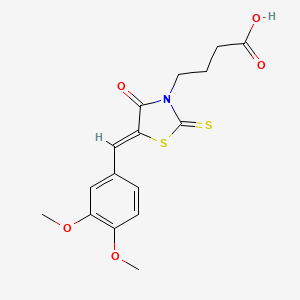

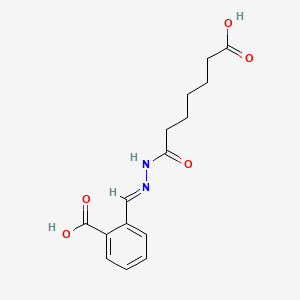
![10-(2-Chloro-6-fluorobenzyl)-8-(4-methylpiperazine-1-carbonyl)dibenzo[b,f][1,4]thiazepin-11(10H)-one](/img/structure/B1674374.png)

